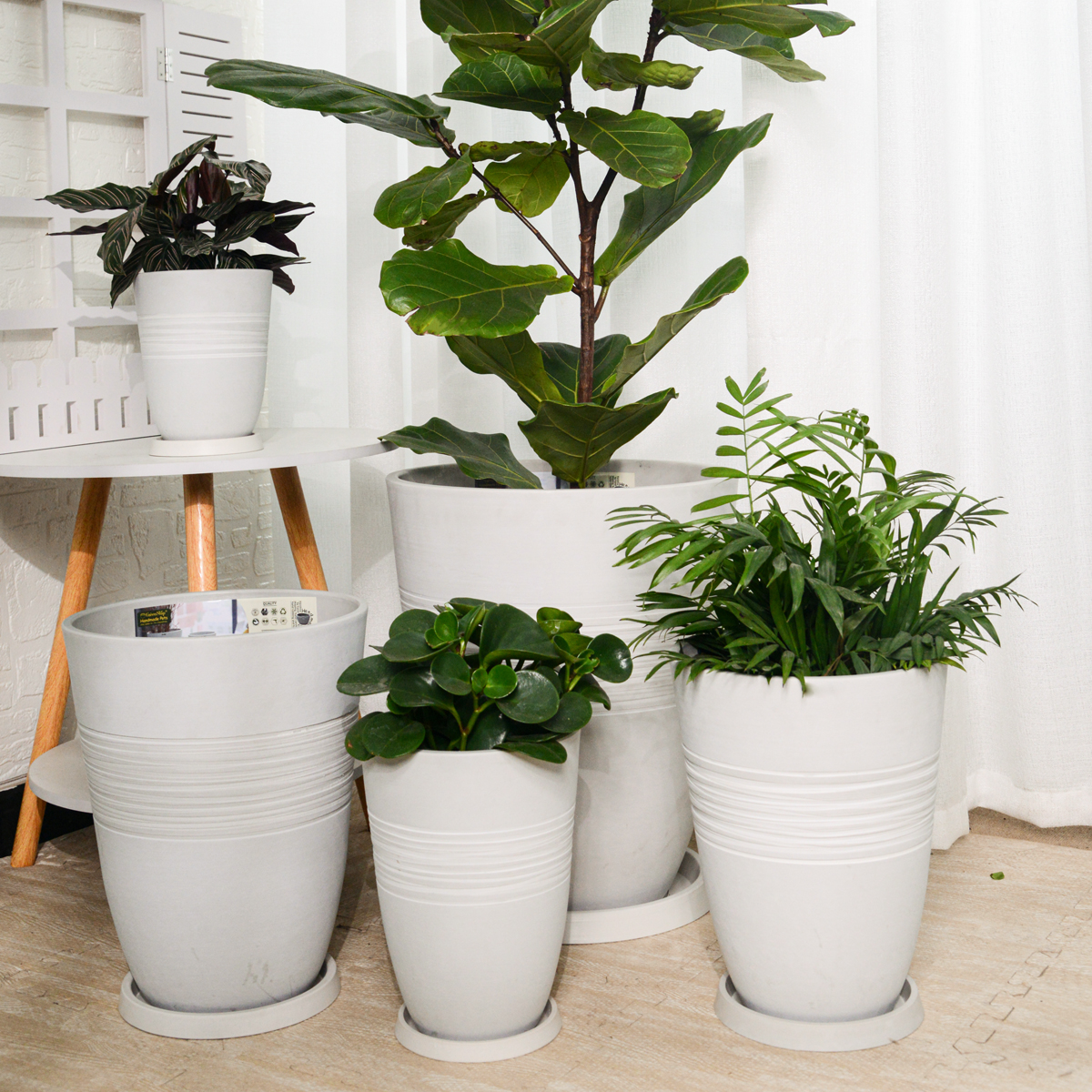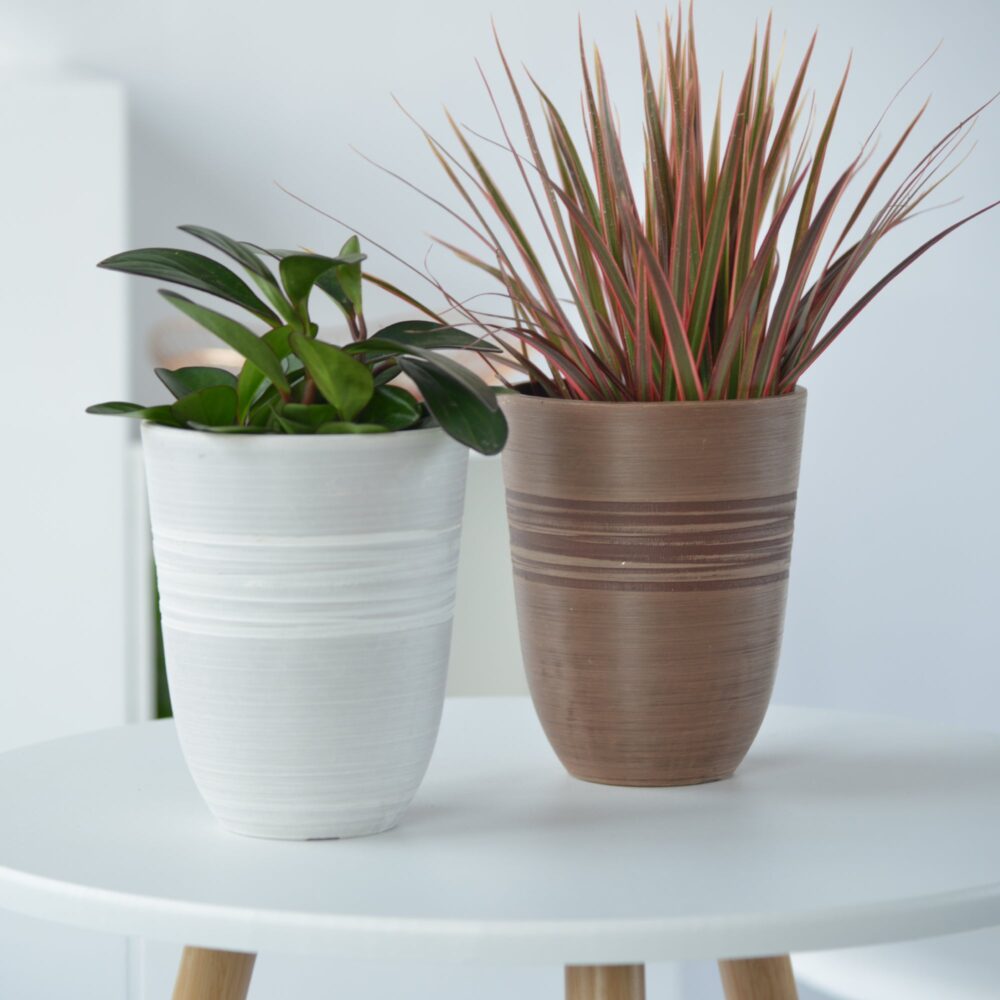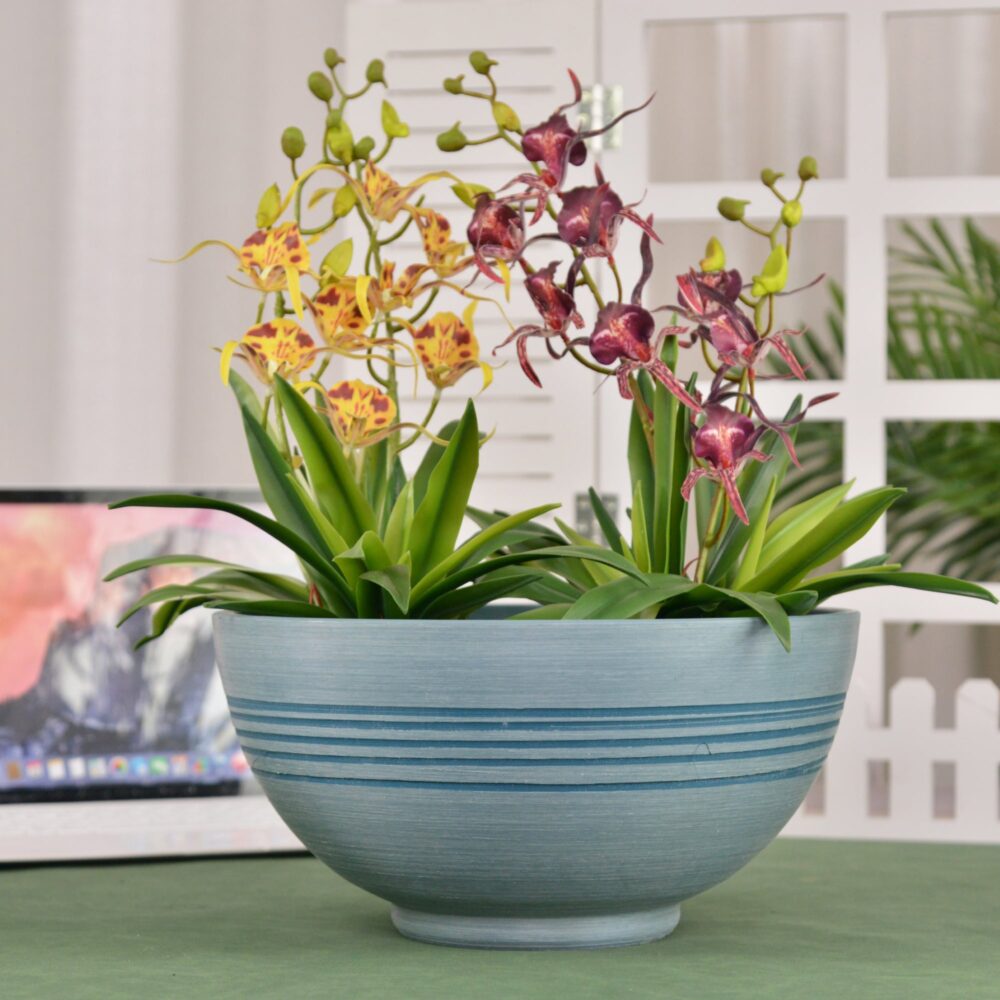Queen of the Night in Pots: The Ultimate Guide to Growing Epiphyllum Outdoors in Containers (Fragrant Night Blooms!)
Want to experience the magic of the Queen of the Night (Epiphyllum oxypetalum) and its legendary, fleetingly beautiful, fragrant blooms? Growing this captivating cactus in containers is a wonderfully rewarding way to enjoy its exotic beauty and nocturnal spectacle, even in limited spaces. Celebrated for its dramatic, large, white, intensely fragrant flowers that bloom only for a single night, its unique flattened, leaf-like stems, its epiphytic nature, and its adaptability to container gardening, the Queen of the Night is perfect for adding a touch of mystery and unforgettable fragrance to your outdoor living areas. This comprehensive guide will provide you with everything you need to know to grow Epiphyllum oxypetalum successfully in outdoor pots, from understanding its unique needs and selecting the best containers to mastering essential care techniques for witnessing its breathtaking, nocturnal floral display.
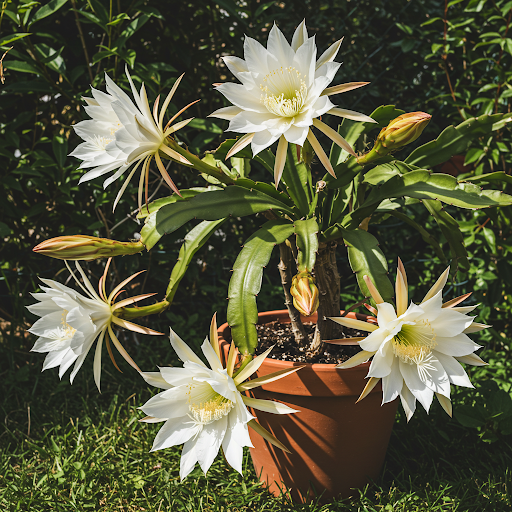
Queen of the Night
What is the Queen of the Night?
The Queen of the Night, scientifically known as Epiphyllum oxypetalum, is a fascinating epiphytic cactus belonging to the Cactaceae family (Cactus family). Native to tropical rainforests in Central and South America, it is widely cultivated as an ornamental plant around the world, prized for its extraordinary and ephemeral flowers, intense fragrance, unusual flattened stems, and nocturnal blooming habit. Epiphyllum oxypetalum is characterized by its flattened, succulent, leaf-like stems (cladodes) that are deeply lobed and function as photosynthetic organs (true leaves are absent or vestigial), its epiphytic growth habit (naturally growing on trees in rainforests, clinging to bark with aerial roots), and its spectacular flowers that are truly its defining feature. The flowers are large (up to 8-12 inches in diameter), trumpet-shaped, pure white, and intensely fragrant, with a rich, sweet, jasmine-like scent. They bloom only for a single night, typically opening late in the evening and wilting by dawn, hence the common name “Queen of the Night.” Flowering is usually profuse and often occurs in flushes during the warmer months. The plant itself has a somewhat sprawling or pendulous growth habit, making it well-suited for hanging baskets or pots where its stems can cascade. Epiphyllum oxypetalum is known for its dramatic and mysterious beauty, its association with nocturnal enchantment, its relatively easy care as a container plant (despite its exotic nature), and the unforgettable experience of witnessing its night-blooming spectacle and fragrance.
Is the Queen of the Night Good for Outdoor Pots?
Yes, the Queen of the Night is exceptionally well-suited for outdoor pots and container gardening, and is often the preferred method of cultivation, even in regions with suitable climates. Container growing perfectly mimics its epiphytic nature and allows for easy management of its specific growing needs. Its adaptability to container culture, manageable size in pots, preference for well-draining soil (easily provided in pots), spectacular nocturnal blooms, and unique stem form make it ideal for container cultivation. Growing Queen of the Night in pots offers several advantages:
- Mimics Epiphytic Habitat: Container gardening closely resembles the natural epiphytic growing conditions of Epiphyllum oxypetalum, allowing you to provide the well-draining, airy root environment it prefers.
- Ideal for Patios and Balconies: Container gardening allows you to enjoy the Queen of the Night even if you have limited garden space, such as on balconies, patios, or decks. They bring exotic beauty and fragrance to paved areas, and their nocturnal blooms are especially enchanting in outdoor living spaces.
- Portability: Potted Queen of the Night plants can be easily moved to optimal locations for sunlight, display, or shelter from extreme weather. You can bring them indoors to protect from cold or excessive rain if needed. Moving pots allows you to position them strategically to best enjoy the fragrance of the night blooms.
- Controlled Soil Conditions: Container gardening allows you to provide the specific well-draining, slightly acidic, and nutrient-rich soil mix that the Queen of the Night requires and control watering and fertilization more precisely, which is crucial for its health and flowering.
- Design Versatility: Queen of the Night plants in pots can be used as standalone specimen plants in decorative pots, displayed in hanging baskets to showcase their cascading stems, grouped together for a dramatic display, or incorporated into mixed container arrangements with other shade-loving tropical plants. Their unique form and nocturnal blooms add an exotic and mysterious element to container gardens.
- Pest and Disease Management: Container growing can help reduce some soilborne pest and disease issues that can affect Queen of the Night plants grown directly in the ground.
- Facilitating Blooming: Container growing, with proper care and slight root restriction, can actually encourage more profuse flowering in Queen of the Night plants compared to planting in the ground.
Ideal Growing Conditions for Queen of the Night in Pots:
Types of Queen of the Night (Species and Cultivars): There aren’t many distinct cultivars of Epiphyllum oxypetalum itself, as the species is already highly prized for its flowers. You will primarily be growing the standard Epiphyllum oxypetalum species. However, you may find variations in flower size or stem form from different sources. Ensure you are obtaining Epiphyllum oxypetalum specifically, as other Epiphyllum species may have different flower colors or bloom times.
Light: Queen of the Night plants prefer bright, indirect light to partial shade. They thrive in bright, filtered sunlight or bright shade. Avoid direct, harsh sunlight, especially afternoon sun, as this can scorch their stems. East-facing patios or balconies that receive morning sun and are shaded in the afternoon are often ideal. When grown in pots outdoors, position them in a location with bright, indirect light or morning sun and afternoon shade. Too much direct sun can cause yellowing or scorching of the stems. Too much dense shade can reduce flowering. Bright, indirect light is key for healthy growth and flowering.
Soil: Queen of the Night plants need very well-draining, airy soil that is rich in organic matter, mimicking their epiphytic rainforest habitat. Use a special orchid potting mix or epiphytic cactus mix, or create your own mix by combining:
- Orchid bark (fir bark): Provides excellent drainage and aeration.
- Coco coir or peat moss: Retains some moisture while maintaining good aeration.
- Perlite or pumice: Further improves drainage and aeration.
- Leaf mold or compost: Adds organic matter and nutrients.
- Optional: Small amount of horticultural charcoal: Helps keep the mix fresh and improves drainage.
Avoid heavy, moisture-retentive potting mixes or garden soil, as these can lead to root rot, which Queen of the Night plants are very susceptible to if their roots stay too wet. Good drainage and aeration are absolutely crucial for healthy Epiphyllum growth in containers.
Watering: Queen of the Night plants prefer to be kept consistently moist during the growing season (spring and summer), but they also need excellent drainage and should not be waterlogged. Water thoroughly when the top inch or two of soil is dry. Water deeply until water drains out of the drainage holes. Then, allow the topsoil to slightly dry before watering again. Avoid overwatering and consistently soggy soil, which is the most common mistake in Epiphyllum care and can lead to root rot. Also, avoid letting the soil dry out completely for extended periods, especially when they are actively growing or budding. They prefer a “cycle of drying out slightly and then thorough watering.” Reduce watering frequency in fall and winter when growth slows down, allowing the soil to dry out more between waterings, but don’t let the stems shrivel from drought. Watering frequency will depend on weather conditions, pot type, and plant size. Water more frequently during warmer, drier periods and less frequently during cooler, more humid periods. Use rainwater or filtered water if possible, as they can be sensitive to salts and minerals in tap water.
Temperature: Queen of the Night plants thrive in warm temperatures, ideally between 65-80°F (18-27°C) during the growing season. They are tropical plants and appreciate warmth. In Singapore’s consistently warm climate, temperature is generally ideal for Queen of the Night year-round. They can tolerate slightly higher temperatures, but avoid extremes of heat or cold. Protect from temperatures below 50°F (10°C), although mature plants can tolerate brief periods of slightly cooler temperatures. Consistent warm temperatures are beneficial for bud development and flowering.
Humidity: Queen of the Night plants prefer high humidity, reflecting their rainforest origins. Singapore’s humidity is generally well-suited to Queen of the Night. They benefit from increased humidity, especially during hot, dry weather. You can increase humidity around potted plants by grouping plants together, using a humidity tray, or misting them occasionally (though good air circulation is also important to prevent fungal issues).
Fertilizer: Queen of the Night plants are moderate feeders and benefit from regular fertilization during their active growing and blooming season to support healthy growth and flowering. Fertilize every 2-4 weeks during the spring and summer growing season (active growth period). Use a balanced liquid fertilizer (e.g., 20-20-20 or 10-10-10) diluted to half strength, or a fertilizer specifically formulated for orchids or cacti and succulents. Follow product label instructions for application rates. A fertilizer slightly higher in phosphorus (the middle number) can encourage better flowering. You can also use a diluted orchid fertilizer regularly. Reduce or stop fertilizing during the dormant period in winter (or during cooler, less active growth periods). Avoid over-fertilizing, which can lead to salt build-up in the soil and damage roots.
Choosing the Right Pots for Queen of the Night:
Suitable Pot Types: Queen of the Night plants need pots that provide excellent drainage and aeration. Suitable pot types include:
- Terracotta Pots: Terracotta is an excellent choice for Queen of the Night as it is porous, allowing for good aeration and drainage, and helps prevent overwatering. Terracotta also provides good stability.
- Orchid Pots: Plastic orchid pots with many drainage holes and slits are specifically designed for epiphytic plants like orchids and Epiphyllum, providing excellent drainage and aeration.
- Hanging Baskets: Hanging baskets are ideal for Queen of the Night as they showcase their cascading stems and allow for excellent air circulation around the roots. Use hanging baskets with good drainage and line them with coco coir or sphagnum moss if needed to help retain some moisture.
- Net Pots (within decorative pots): Queen of the Night can be grown in net pots (plastic mesh pots) placed inside decorative cache pots. Net pots provide maximum aeration and drainage.
Drainage: Excellent drainage is absolutely essential for Queen of the Night to prevent root rot. Ensure your chosen pot has plenty of drainage holes at the bottom and sides if possible (like orchid pots). Avoid pots without drainage holes. Do not use a drainage layer of gravel at the bottom of the pot, as this can actually impede drainage in containers. Focus on using a very well-draining potting mix and pots with ample drainage holes.
Pot Size: Choose pot sizes appropriate for the size and maturity of your Queen of the Night plant and your desired display. They are not overly vigorous growers and do not need very large pots, but provide enough room for their root system and stem development.
- Young Plants or Cuttings: Start with pots that are 6-8 inches in diameter.
- Mature Plants (Medium-Sized): Use pots that are 8-12 inches in diameter.
- Larger, More Mature Specimens: Pots that are 12-16 inches in diameter or slightly larger can be used for very mature, larger plants. Generally, Queen of the Night plants do not need pots larger than 16 inches in diameter, even when mature.
- Depth: Pot depth should be roughly equal to the diameter, or slightly less. They are not deep-rooted plants. Hanging baskets can be shallower.
Stability: Queen of the Night plants are generally not very top-heavy, but using slightly heavier pots (terracotta or ceramic) can provide good stability, especially for larger, more mature plants or if using taller pots. Hanging baskets are naturally stable when hung.
Material (Breathability): Terracotta pots are often preferred for Queen of the Night because they are breathable and allow for better aeration of the root zone. If using plastic or glazed ceramic pots, be extra careful not to overwater and ensure the potting mix is very well-draining. Net pots offer maximum breathability.
Essential Care Tips for Thriving Queen of the Night in Outdoor Pots:
- Watering: “Water Regularly During Growing Season, Allow Top Inch of Soil to Dry Between Waterings”.Water thoroughly when top inch of soil is dry during growing season. Use well-draining mix and pots. Avoid overwatering. Reduce watering in winter.
- Sunlight: Provide Bright, Indirect Light to Partial Shade (Avoid Harsh Sun). Place Queen of the Night pots in a location with bright, indirect light or morning sun and afternoon shade outdoors. Protect from harsh afternoon sun.
- Fertilizing: Fertilize Every 2-4 Weeks During Growing Season with Balanced Liquid Fertilizer or Orchid Fertilizer. Fertilize regularly during the spring and summer growing season to promote healthy growth and flowering. Use balanced liquid fertilizer or orchid fertilizer. Reduce or stop fertilizing during dormancy.
- Humidity (High Humidity Preferred): Queen of the Night plants appreciate high humidity. Increase humidity if needed, especially in dry climates.
- Support (Provide Support for Stems if Needed): While they don’t typically need staking, you can provide some support for stems if they become very long or pendulous, or use hanging baskets to accommodate their growth habit.
- Night Bloom Observation (Enjoy the Fragrance and Ephemeral Flowers!): The most important care tip is to be prepared to enjoy the spectacular night blooms! Be sure to check your plants regularly in the late evening during the blooming season (warmer months) to witness the flowers open and enjoy their intense fragrance. The flowers only last for one night, so don’t miss the show!
Popular Queen of the Night “Cultivars” (Variations within Epiphyllum oxypetalum Species):
As mentioned, there are not many formal cultivars of Epiphyllum oxypetalum. Variations you might find relate to:
- Flower Size: Some sources may offer plants with slightly larger or smaller flowers.
- Stem Form: Variations in stem lobe depth or overall stem shape may occur.
- Fragrance Intensity: Slight variations in fragrance intensity may be observed between different plants.
- “Monstrose” Forms: Occasionally, you might find “monstrose” forms with crested or fasciated stems, which are botanical curiosities but have the same night-blooming flowers.
When purchasing, ensure you are getting Epiphyllum oxypetalum if you are specifically seeking the classic Queen of the Night with large, white, fragrant nocturnal blooms.
In Summary:
Growing Queen of the Night (Epiphyllum oxypetalum) in outdoor pots is a wonderfully rewarding way to experience the magic of these extraordinary night-blooming cacti. Their spectacular, fragrant, and ephemeral flowers, unique stem form, and adaptability to containers make them a perfect choice for container gardeners of all levels, especially those seeking exotic, fragrant, and relatively low-maintenance plants for patios, balconies, and outdoor living areas. By providing bright, indirect light, very well-draining, airy potting mix in pots with excellent drainage, watering regularly during the growing season, fertilizing, and ensuring high humidity, you can easily cultivate thriving and spectacularly blooming Queen of the Night plants in pots and enjoy their unforgettable nocturnal floral displays and intoxicating fragrance in your outdoor spaces for years to come.
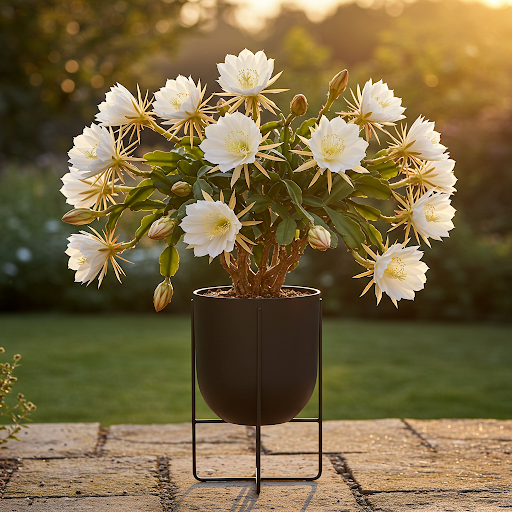
Queen of the Night
For more detailed botanical information and to explore the fascinating world of Epiphyllum oxypetalum, you can visit the Wikipedia page on Epiphyllum oxypetalum.
Important Note: The magic of the Queen of the Night is in its night blooms! Be patient, provide the right conditions, and you will be rewarded with the unforgettable spectacle and fragrance of these extraordinary nocturnal flowers. Don’t forget to set an alarm to witness the fleeting beauty of the Queen!**
KC2-11VH
By greenship|2024-08-16T06:19:28+00:00August 16, 2024|Categories: Hand-carving Series|
Planter 6 in W / 8 in W / 12 in W Indoor or Outdoor Plants, Modern Decorative Plant Pots with Drainage Hole, Decorative Flower Pots
By greenship-seo|2025-02-06T13:43:53+00:00January 16, 2025|Categories: Hand-carving Series|Tags: Decorative Flower Pots|
20T
By greenship|2024-08-13T06:42:22+00:00August 13, 2024|Categories: Hand-carving Series|
k2-21G
By greenship|2024-08-13T06:17:26+00:00August 13, 2024|Categories: Hand-carving Series|
Plant Pots 6 inch 8 inch 10 inch for Indoor Plants, Set of 3 Modern Decorative Planter ts with Drainage Hole, Decorative Flower Pots
By greenship-seo|2025-04-10T06:39:28+00:00January 14, 2025|Categories: Hand-carving Series|Tags: Decorative Flower Pots|
13 inch Planter for Indoor Plants, Set of 2 Modern Decorative Plant Pots with Drainage Hole, Cute Bowl Shape Flower Pots
By greenship-seo|2025-04-10T07:41:46+00:00January 10, 2025|Categories: Hand-carving Series|Tags: Decorative Flower Pots, Self-Watering Pots|

